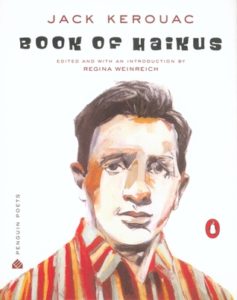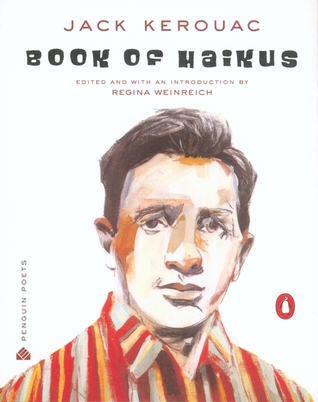#8 KEROUAC’S HAIKU–Part One: Hanging by a Self Shat Thread

Recently I attended Tom Peters’ long-running poetry reading series (35 years of consecutive Monday nights!) here in Boulder. Tom runs the Beat Book Shop on the Pearl Street Mall, and every year gives time for people to take the stage and read from Jack Kerouac’s work. This year we commemorated a hundred years since Kerouac’s birth.
Jack loved writing what seemed like unending sentences (if I’m not mistaken, On the Road originally comprised a single sentence), and you get a lot of dense paragraphs in small type. Hard on my old eyes, as I looked through the books on my shelf, and maybe not ideal for staying cleanly on the wording in performance.
Instead, I pulled down Book of Haikus, a posthumous–and near exhaustive collection–of Kerouac’s work in a polar opposite form to his prose.
Pat Donegan trained me in haiku practice at Naropa University, initiating my own lifelong engagement with the form. She introduced us to a few of Jack’s, this one still a favorite:
In my medicine cabinet
the winter fly
Has died of old age
Haiku of course is a Japanese form, and nowadays it’s been absorbed into English; people dedicate magazines and websites to it, and continue to bend it into all kinds of shapes, but when Kerouac undertook to write it, it was new for a western writer to take up its form and make it work in American English and American milieu.
But you can see right away how Kerouac grasped the magic of the ordinary, daily perception that’s so much a part of the haiku ethic/aesthetic. The routine moment of opening your medicine cabinet and seeing a dead bug there might not register above the level of “I need to clean the shelf,” if at all, but here he not only notices this tiny corpse, you can feel the reality of old age and death there, with the withered, cold sense that miniscule detail has against the backdrop of winter. Kerouac sees, feels, and expresses that in a few words describing a perfectly ordinary human moment, and suddenly you might absorb what that moment really implies.
Crossing the football field,
coming home from work,
The lonely businessman.
Here you get the space around the solitary figure through “football field” and the contrast you don’t immediately expect of a business man on one. “Lonely” locates the feeling tone, but he dedicates the rest of the words to constructing the picture.
That’s the essence of the game, really. How much can you capture in the fewest possible words, as you’re most often describing the everyday. Do it right, and you’ve crystallized this tiny world that suddenly becomes its own universe:
In the morning frost
the cats
Stepped slowly
You can almost feel the cold texture on their paws. Through the lens of the poem, you’re stepping with them.
Frozen
in the birdbath,
A leaf
With haiku, including the classical ones still reproduced in tomes of great Japanese literature, you have to wonder sometimes, “Is this important? What’s it saying? Anything?” In this one you might read into it a metaphor for how something gets caught, trapped in a situation (like the fly in the medicine cabinet). There’s some intuitive feeling of that, perhaps, and yet I’m also taken with the stark elegance.
I’m struck, as well, by how few words Kerouac employs to get it across. A normally word drunk prose writer, he’s honed what’s supposed to be a 17 syllable form down to less than half that, and still something comes across. Allen Ginsberg, teaching haiku, came down firmly on the 17 syllable length as determinative of how it might land properly, yet clearly Kerouac didn’t feel the same need, and many (most?) haiku he wrote come in well under the count.
Cat eating fish heads
–All those eyes
In the starlight.
One way he succeeds in this form comes through vividly getting the gist without belaboring it, then the poem has a deep resonance, where the blank eyes of dead fish hold a universe of stars.
Giving an apple
to the mule, the big lips
Taking hold.
You get the mule’s desirous interest here, but it’s the lips that stand out vibrantly, sensually, and hold the attention as they stretch to get around the fruit. Just like flies, humans die of old age; they also voraciously reach for purchase on the object of desire, and here’s the mule doing it in its own, inimitable way. In haiku, you have to make the point and communicate a feeling, usually through image, and say no more.
In fact, as I think Ginsberg did not know—and I learned relatively recently–the 17 syllable limit in Japanese haiku hasn’t been followed with any absolutism, and many haiku are much shorter. Pat Donegan, whom I got a chance to spend an evening with decades after the classes I took with her, emphasized that Japanese haiku was “just a suggestion,” like those minimal Japanese ink paintings—a few strokes and you’ve got a sparrow on a branch and mostly the blank space of the paper through and around that sparrow, the formless space pervading a minimal but lively form.
The little worm
lowers itself from the roof
By a self shat thread
Here’s vast space and a tiny existence somehow continuing in the midst of it, hanging by its own frail creation. Kerouac clearly resonates with Issa (1763-1827) in his tender appreciation for animals and insects. Here’s an example of Issa (put into English by Robert Hass):
Don’t worry, spiders,
I keep house
casually.
Issa has a consistent magnanimity toward other sentient beings of the universe, and does resonate with their concerns. Kerouac:
I woke up
–two flies were boffing
On my forehead
Pat Donegan used to talk about “surprise mind.” Here the poet wakes up surprised by the existence of other beings in their own world using his forehead as a honeymoon suite. It’s those sometimes sharply-contrasted juxtapositions that jolt us, though often the juxtapositions are more subtle—like the tiny, struggling, vulnerable sentience of the worm and the implied immensity of space surrounding it. Kerouac gooses the humor through the American slang “boffing,” chosen over a lot of other terms he might have used, either cruder or more technical. He finds the one that’s jocular—like Issa, he has a friendly, ironic smile from the larger universe at the doings of sentient beings.
Resting watchfully, the cat
and the squirrel
Share the afternoon
This has life and death drama, routine game playing, and an amused take on how beings spend their lives—suspended in a conflict of predation, an attentiveness to escape predation, and an almost peaceful acceptance of the diurnal game that simultaneously separates and binds the antagonists. You could write a thousand page novel with that plot set up, but Kerouac evokes it in ten words through observation of his own backyard.
Catfish fighting for his life,
and winning,
Splashing us all
In this one, it really is a life and death moment, and the preyed upon triumphs over the predators, with enough panache to drench them with its victory. There’s no special vocabulary employed—plain spoken English that nevertheless tautly evokes the vitality that survives to leap free.
Kerouac demonstrates again and again the selfsame sensitivity and appreciation the classical haiku poets felt toward the fine details going on in the world around them. He shapes that accordingly using his own American tongue, but capable of a bull’s eye concision Basho might have appreciated.
(Next time, KEROUAC’S HAIKU–Part Two: The Luminous Dregs of My Coffee)


I wish I’d had this available to me when I was teaching haiku to my students. I’m looking forward to reading Part II, and thinking I may want to read more haiku in the meantime!
I just posted some more today–three parts when I’m finished! I hope it does inspire you. And it’s fun to write, and even if you think your haiku isn’t good, you didn’t use of ton of paper on it.
Thanks for this blog Gary, I learned a lot plus laughed. some etoo
Pesky recent visitor
departed slowly
leaving soggy kleenex’s
This might fit into Part Three next week when I do Kerouac’s “people” haiku.